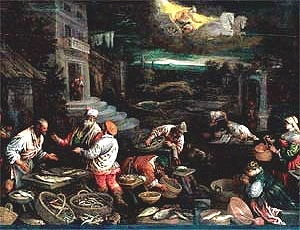 |
|
Allegories of Fire and Water
Bassano Paintings
Jane Peterson. 2000
The two paintings are from Gallery 6 and by Francesco Bassano (1549-1592) who worked in
collaboration with his father, Jacopo. They are The Allegory of Fire and The Allegory of
Water , both of which offer some interesting insights about Renaissance iconography. |
The physical elements of the world in the l6th
century were considered to be earth, air, fire and water. These elements were popular
subjects for painting, usually done in sets of four. (For information about other sets and
the two missing from the Ringling collection, see Peter Tomory's Catalogue of the Italian
Paintings before 1800).
The Allegory of Fire shows a balding, plebeian Vulcan hammering at his anvil while and
assistant heats a metal object in the furnace behind him. In the near foreground, Cupid is
playing with a dog, while Venus, her back to the viewer, attends to her own matters. The
foreground is strewn with pots, candlesticks, jugs and pieces of armor. In the middle
ground a woman is busy gathering objects into a large barrow, while other more distant
figures are at work collecting tinder and wood and tending hearth fires. The flames of Mt.
Etna shoot up in the background. Streaking across the nighttime sky is a robed figure in a
chariot pulled by wolves.
 |
|
In the lower left corner of the Allegory of Water, one
sees a burgeoning fish market where two gentlemen haggle with a vendor. On the right one
woman is drinking at the well, and a second carries a bucket of water. In the middle
ground kneeling at the river bank two women tend to their laundry, while a boat can be
seen leaving the opposite bank to travel down the river. A bridge crosses the water in the
background. Again a bearded figure in a chariot, this time pulled by two horses, crosses
the sky.It is these two figures flying through the heavens that offer a problem in
iconography. A serious study of Renaissance iconography runs into a knotty question. How
did the pagan gods survive in the Middle Ages? For a thousand years, the Christian church
dominated the thought and proscribed interest in the classics and the mythology of the
ancients. The Renaissance, of course initiated a new interest in the study of ancient
literature. |
These classical gods are reintroduced in
Renaissance art and literature in a number of ways although many changes take place.
One of the ways in which these gods survived in the dark ages was through astrology.
Heavenly objects, stars and constellations were named for mythological beings, and the
planets were named for gods. In astrology, the planets were thought to hold sway over
earthly life, and influences of the planets were imbued with attributes of those gods for
which they were named.
It is the planet Mars which is seen charging through the sky in The Allegory of Fire. This
planet was thought to influence those natures which were hot-blooded and aggressive. It
incited fiery emotions and quarrelsome attacks. It controlled the feverish diseases.
The modern mind leaps to the conclusion that Neptune must be the guiding force in the
Allegory of Water. However, since the planet Neptune was not identified or named until the
middle of the 19th century, it could hardly appear in a 16th century painting. It is
rather the planet Saturn which influenced the phlegmatic humors. That planet was
responsible for the cold-blooded, frigid, sardonic natures. It induced teary emotions and
controlled the watery rheumy diseases. It is Saturn which streaks through The Allegory of
Water.
This is a superficial discussion of a fascinating and involved subject. If it has piqued
your interest, there are several good books for reference. Studies In Iconology by Erwin
Panofsky discusses Father Time and Blind Cupid in Chapters 3 and 4, and the Survival of
the Pagan Gods by Jean Seznec treats the matter in great depth.
|

